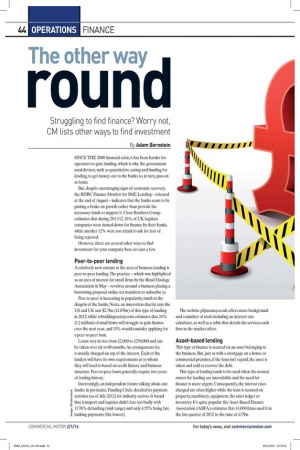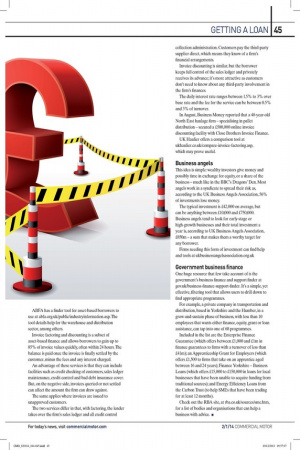The other way round
Page 40

Page 41

If you've noticed an error in this article please click here to report it so we can fix it.
Struggling to find finance? Worry not, CM lists other ways to find investment By Adam Bernstein
SINCE THE 2008 financial crisis, it has been harder for operators to gain funding, which is why the government used devices, such as quantitative easing and funding for lending, to get money out to the banks to, in turn, pass on as loans.
But, despite encouraging signs of economic recovery, the BDRC Finance Monitor for SME Lending — released at the end of August — indicates that the banks seem to be putting a brake on growth rather than provide the necessary funds to support it. Close Brothers Group estimates that during 2011/12,16% of UK logistics companies were turned down for finance by their banks, while another 12% were too afraid to ask for fear of being rejected.
However, there are several other ways to find investment for your company: here are just a few. Peer-to-peer tending
A relatively new entrant to the area of business lending is peer-to-peer lending. The practice — which was highlighted as an area of interest for small firms by the Road Haulage Association in May — revolves around a business placing a borrowing proposal online for members to subscribe to.
Peer-to-peer is increasing in popularity, much to the chagrin of the banks. Nesta, an innovation charity, says the US and UK saw $2.7bn (£1.67bn) of this type of lending in 2012; while rebuildingsociety.com estimates that 24% (12 million) of small firms will struggle to gain finance over the next year, and 15% would consider applying for a peer-to-peer loan.
Loans vary in size from £2,000 to £250,000 and can be taken over six to 60 months. An arrangement fee is usually charged on top of the interest. Each of the lenders will have its own requirements as to whom they will lend to based on credit history and business structure. Peer-to-peer loans generally require two years of trading history. Interestingly, an independent forum talking about one t lender in particular, Funding Circle, detailed its payment 'Z. statistics (as of July 2012) for industry sectors. It found
that transport and logistics didn't fare too badly with g 11.76% defaulting (mid-range) and only 4.55% being late 2 making payments (the lowest).
The website p2pmoney.co.uk offers more background and a number of tools including an interest rate calculator, as well as a table that details the services each firm in the market offers. Asset-based tending
This type of finance is secured on an asset belonging to the business. But, just as with a mortgage on a home or commercial premises, if the loan isn't repaid, the asset is taken and sold to recover the debt.
This type of lending tends to be used when the normal routes for lending are unavailable and the need for finance is more urgent. Consequently, the interest rates charged are often higher while the loan is secured on property, machinery, equipment, the sales ledger or inventory. It's quite popular: the Asset Based Finance Association (ABFA) estimates that 43,000 firms used it in the last quarter of 2012 to the tune of £17bn.
ABFA has a finder tool for asset-based borrowers to use at abfa.org.uk/public/industryinformation.asp. The tool details help for the warehouse and distribution sector, among others.
Invoice factoring and discounting is a subset of asset-based finance and allows borrowers to gain up to 85% of invoice values quickly, often within 24 hours. The balance is paid once the invoice is finally settled by the customer, minus the fees and any interest charged.
An advantage of these services is that they can include facilities such as credit checking of customers, sales ledger maintenance, credit control and bad debt insurance cover. But, on the negative side, invoices queried or not settled can affect the amount the firm can draw against.
The same applies where invoices are issued to unapproved customers. The two services differ in that, with factoring, the lender takes over the firm's sales ledger and all credit control
collection administration. Customers pay the third-party supplier direct, which means they know of a firm's financial arrangements.
Invoice discounting is similar, but the borrower keeps full control of the sales ledger and privately receives its advance; it's more attractive as customers don't need to know about any third-party involvement in the firm's finances.
The daily interest rate ranges between 1.5% to 3% over base rate and the fee for the service can be between 0.5% and 3% of turnover.
In August, Business Money reported that a 40-year-old North East haulage firm — specialising in pallet distribution — secured a £500,000 online invoice discounting facility with Close Brothers Invoice Finance.
UK Haulier offers a comparison tool at ukhaulier.co.uk/compare-invoice-factoring.asp, which may prove useful. Business angels
This idea is simple: wealthy investors give money and possibly time in exchange for equity, or a share of the business — much like in the BBC's Dragons' Den. Most angels work in a syndicate to spread their risk as, according to the UK Business Angels Association, 56% of investments lose money.
The typical investment is £42,000 on average, but can be anything between £10,000 and £750,000. Business angels tend to look for early-stage or high-growth businesses and their total investment a year is, according to UK Business Angels Association, £850m — a sum that makes them a worthy target for any borrower. Firms needing this form of investment can find help and tools at ukbusinessangelsassociation.org.uk Government business finance
One huge resource that few take account of is the government's business finance and support finder at gov.uk/business-finance-support-finder. It's a simple, yet effective, filtering tool that allows users to drill down to find appropriate programmes. For example, a private company in transportation and distribution, based in Yorkshire and the Humber, in a grow-and-sustain phase of business, with less than 10 employees that wants either finance, equity, grant or loan assistance, can tap into one of 68 programmes
Included in the list are the Enterprise Finance Guarantee (which offers between £1,000 and ilm in finance guarantees to firms with a turnover of less than £41m); an Apprenticeship Grant for Employers (which offers £1,500 to firms that take on an apprentice aged between 16 and 24 years); Finance Yorkshire — Business Loans (which offers £15,000 to £150,000 in loans for local businesses that have been unable to acquire funding from traditional sources); and Energy Efficiency Loans from the Carbon Trust (to help SMEs that have been trading for at least 12 months). Check out the RBA site, at rba.co.uk/sources/sme.htm, for a list of bodies and organisations that can help a business with advice. •












































